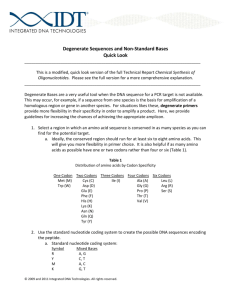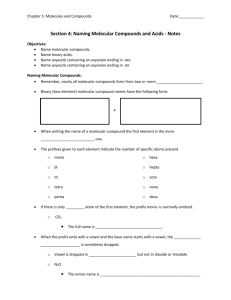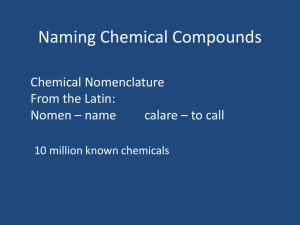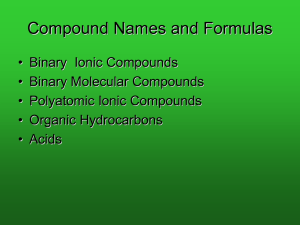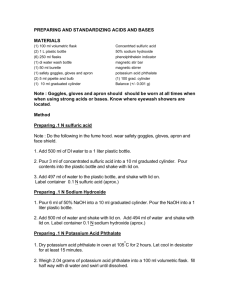Neutralization reactions
advertisement
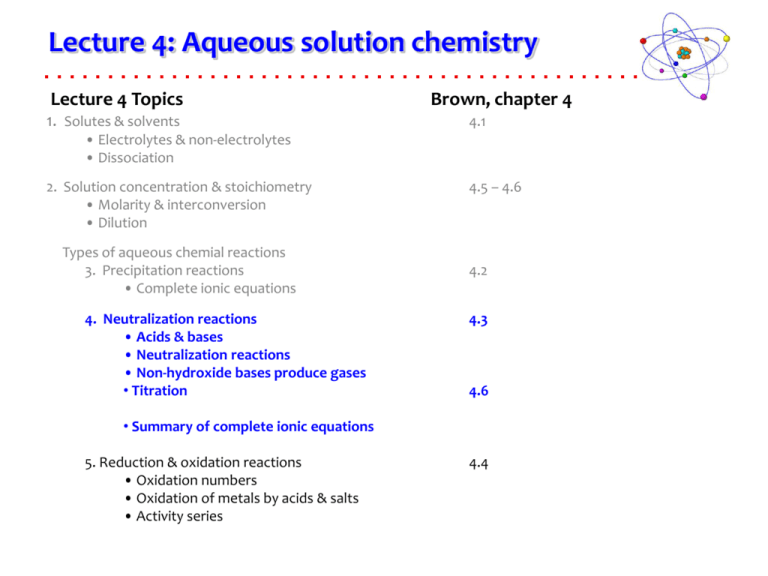
Lecture 4: Aqueous solution chemistry Lecture 4 Topics 1. Solutes & solvents Brown, chapter 4 4.1 • Electrolytes & non-electrolytes • Dissociation 2. Solution concentration & stoichiometry • Molarity & interconversion • Dilution Types of aqueous chemial reactions 3. Precipitation reactions • Complete ionic equations 4. Neutralization reactions • Acids & bases • Neutralization reactions • Non-hydroxide bases produce gases • Titration 4.5 – 4.6 4.2 4.3 4.6 • Summary of complete ionic equations 5. Reduction & oxidation reactions • Oxidation numbers • Oxidation of metals by acids & salts • Activity series 4.4 Neutralizations create salt & water by reacting acids & bases Acids donate protons. Bases accept protons. Sulfur & carbonate bases produce gases. Titrations determine concentrations. Acids & bases Acids Compounds that ionize in solution to form a H+ ion; proton donors So acids increase the [H+] and lower pH. Acids taste? Sour Bases Compounds that accept a H+ ion; proton acceptors So acids decrease the [H+] and increase pH. Bases taste? Bitter pH measures the concentration of free H+ on a log scale. Inverse: high [H+] = low pH Coca-cola - pH 1-2 Bleach & ammonia - pH 13-14 Both acids & bases exist in forms that can donate or accept multiple H+: Monoprotic acid: HCl, HBr, HI, HF These acids can donate as many protons as Diprotic acid: H2SO4 Triprotic acid: H3PO4 they have: 1 for mono; 2 for di; 3 for tri. Usually only the first H+ is released easily, so the acids ‘strength’ is not additive. Similarly bases can be mono-, di-, or tri- basic: NaOH, Ca(OH)2, Al(OH)3 So monobasics accept 1 H+, dibasics accept 2 H+ & tribasics accept 3 H+. Unusual base? (non-OH) NH3 + H+ --> NH4+ Note that NH4+1 can act as an acid. Ammonia & ammonium are weak bases & acids. Strong acids & bases? There are 7 strong acids: HCl, HBr, HI, HNO3, H2SO4, HClO3, HClO4 Strong bases? If the metal is from column 1A or Ca, Sr, Ba Remember that all strong acids & bases are strong electrolytes p.128-31 Acid-base conjugate pairs Are pairs of molecules that differ only by a single hydrogen. The shift from acid to base is due to transfer (aka donation) of a H+1 ion (or proton) from the acid to the base. • The acid (H2O) becomes its conjugate base (OH-1). • The base (NH3) becomes its conjugate acid (NH4+1). Two conjugate pairs are shown here: Top: OH-1 is the conjugate base of water. Bottom: NH4+1 is the conjugate acid of ammonia. p.129 Neutralizations: acid-base reactions Reactions between acids & base: Are exchange reactions. Produce water and a ‘salt’. Produce a neutral pH (~7). HCl + NaOH H2O + NaCl 1-2 acid 12-13 7 adding base NA pH values neutralized p.132-4 1. 2. 3. Neutralization details HCl + NaOH H2O + NaCl 1-2 12-13 7 NA pH values Neutralization rxn’s can also be analyzed as complete & net ionic equations: HCl + NaOH H2O + NaCl H+ + Cl- + Na+ + OH- H2O (pure liquid) + Na+ + Cl--H+ + Cl- + Na+ + OH- H2O (pure liquid) + Na+ + Cl- Water does not dissociate; it’s not an ionic, but a molecular compound. Since all neutralization rxns produce water the net ionic equation of all neutralizations is H+ + OH- H2O. More neutralization examples: products, balance, complete & net Mg(OH)2(ppt) + 2 HCl(aq) Mg+2 + 2Cl-1 + 2H2O H2SO4(aq) + 2 KOH(aq) 2K+1 + SO4-2 + 2H2O(l) 4H3PO4(aq) + 6 Ca(OH)2(aq) 2Ca3(PO4)2 (ppt) + 12H O(l) 2 p.132-4 Non-hydroxide bases form gases When an acid reacts with a non-hydroxide base a gas is formed rather than water gas + salt • CO3-2 ion • S-2 ion ions that form non-hydroxide bases 2 HCl(aq) + Na2S(aq) H2S(g) + 2NaCl(aq) 2H+1(aq) + 2Cl-1(aq) + 2Na+1(aq) + S-2(aq) H2S(g) + 2Na+1(aq) + Cl-1(aq) HCl(aq) + NaHCO3(aq) H2CO3(aq) + NaCl(aq) H2O(l) + CO2(g) H+1(aq) + Cl-1(aq) + Na+1(aq) + HCO3-1(aq) Na+1(aq) + Cl-1(aq) + H2O(l) + CO2(g) So here the net reaction is the production of water and CO2 gas. Note: neither gases nor water (a pure liquid) dissociate. The gas actually just bubbles out of solution. Why does H2CO3 dissociate? It’s a weak but unstable acid & spontaneously decomposes to water & CO2 p.134-5 Recap: complete ionic equations When writing complete ionic equations for precipitation or neutralization reactions there are three types of products (or chemical species) that NEVER DISSOCIATE: 1. Solids/precipitates - so strongly attracted that water can’t break them up 2. Water (or other pure liquids) - are molecular (or non-electrolytes) and so dilute, but do not dissociate 3. Gases - are not soluble in water (or aqueous solutions) and bubble away - Gases are also molecular. Titration An experimental method for determining the concentration of a chemical. Requirements: 1. A chemical that will react with the unknown & whose concentration is known 2. A balanced chemical equation 3. M & volume of the standardized solution 4. An indicator that tells you when the reaction is complete; pH-sensitive dye @ pH 7.0 You can titrate 10.0 mL of unknown HCl solution with 43.2 mL of a 0.15 M NaOH solution. What’s the concentration of the HCl? Steps: HCl + NaOH --> H2O + NaCl equivalence point ~pH 7.0 10.0 mL 43.2 mL ?? M 0.15 M 0.0432 L 0.15 mol NaOH 1 mol HCl = 0.648 M HCl 1L 1 mol NaOH 0.0100 L HCl 1. Bal equation 2. Assoc. data 3. Standard? 4. Moles standard 5. A -> B moles 6. Divide by L B How many grams of Cl-1 in a water sample if 20.2 mL of 0.100 M Ag+1 is needed to titrate? Ag+1 + Cl-1 --> AgCl(s) 20.2 mL 0.100 M 0.0202 L 0.100 mol Ag+1 1 mol Cl-1 35.45 g Cl-1 = 0.0717 g Cl-1 1L 1 mol Ag+1 1 mol p.150-3 Putting it all together! A 70.5 mg sample of potassium phosphate is added to 15.0 mL of 0.050 M silver nitrate, resulting in precipitation. 1. Write the balanced chemical equation 2. What is the limiting reactant? 3. Calculate theoretical yield (g) of precipitate. K3(PO4) + 3Ag(NO3) Ag3(PO4)ppt + 3K(NO3) 0.0705 g 15.0 mL 0.050 M 0.0705 g 1 mole K3(PO4) 1 mole Ag3(PO4) 418.59 g Ag3(PO4) = 0.139 g 212.24 g 1 mole K3(PO4) 1 mole Ag3(PO4) 0.0150 L 0.050 mole Ag(NO3) 1 mole Ag3(PO4) 1L 3 mole Ag(NO3) 418.59 g Ag3(PO4) = 0.105 g 1 mole Ag3(PO4) So Ag(NO3) is limiting, and the theoretical yield of ppt is 0.105 g p.153
